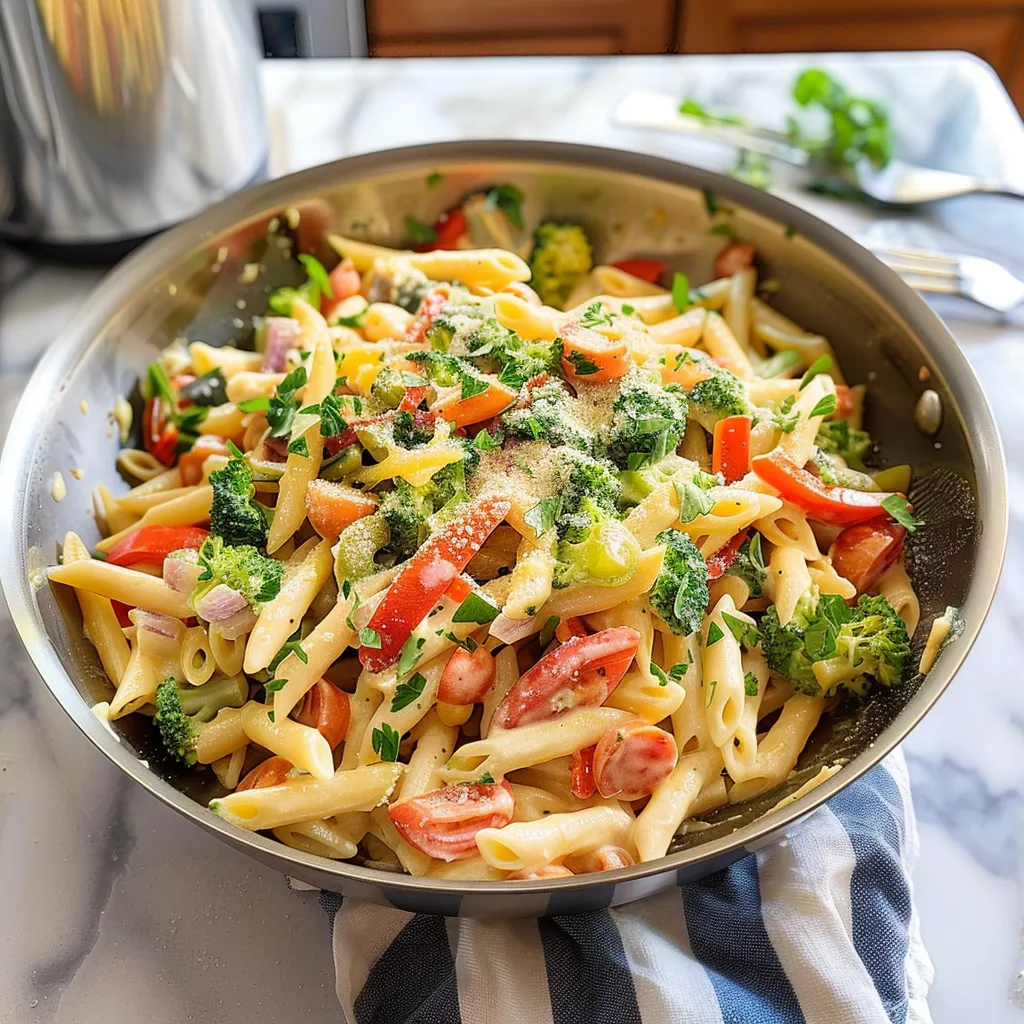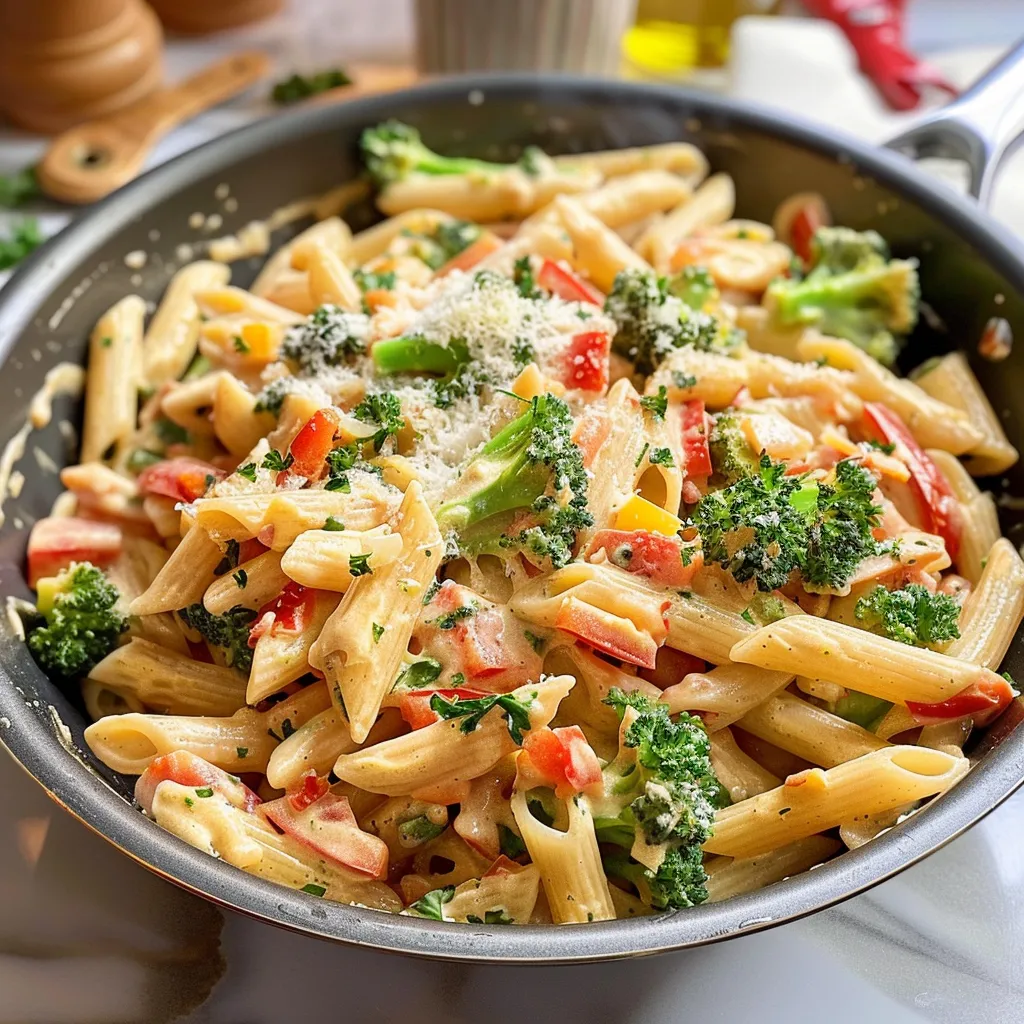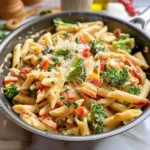Pasta Primavera: A Fresh & Flavorful Veggie Delight

Vibrant, fresh, and utterly delightful, Pasta Primavera is the quintessential dish that celebrates the bounty of seasonal vegetables. Originating from Italy, this colorful pasta dish not only tantalizes the taste buds but also offers a canvas for culinary creativity. Imagine fusing al dente pasta with an array of crisp vegetables, lightly sautéed in olive oil, and finished with a sprinkle of cheese and herbs. The beauty of this dish lies in its versatility; you can easily adapt it to suit your palate or pantry. Try swapping out traditional vegetables like bell peppers and zucchini for asparagus, broccoli, or even peas to create your own twist. Another tip for achieving that perfectly balanced flavor is to experiment with different olive oils and spices. Whether you’re looking for a quick weeknight meal or an impressive dinner for guests, capturing the essence of this dish is simple and rewarding. Let’s dive into the recipe and explore how to bring these delicious flavors to your table!
Ingredients for Pasta Primavera:
This vibrant and versatile dish is perfect for serving a crowd. Below is a comprehensive list of ingredients to prepare Pasta Primavera for 8–10 servings, ensuring that each bite showcases the freshness of seasonal vegetables and the richness of the pasta.
Pasta
- 2 pounds (900g) of your choice of pasta (like penne, fusilli, or spaghetti)
Vegetables
- 1 cup (150g) of bell peppers, assorted colors, sliced
- 1 medium-sized zucchini, diced
- 1 medium-sized yellow squash, diced
- 1 cup (150g) of asparagus, cut into 1-inch pieces
- 1 cup (150g) of cherry tomatoes, halved
- 1 cup (150g) of broccoli florets
- 1 cup (150g) of snap peas or sugar snap peas
- 2 cups (300g) of spinach, fresh
Aromatics and Seasonings
- 4 tablespoons (60ml) of olive oil, extra virgin
- 4 cloves of garlic, minced
- 1 teaspoon of salt (to taste)
- ½ teaspoon of freshly ground black pepper (to taste)
- 1 teaspoon of red pepper flakes (optional, for added heat)
Herbs and Cheese
- ½ cup (around 15g) of fresh basil leaves, chopped or torn
- ½ cup (50g) of grated Parmesan cheese (use nutritional yeast for a vegan option)
- 1 tablespoon of lemon zest (from about 1 lemon)
- Juice of 1 lemon (for brightness and flavor)
Optional Variations
Feel free to customize your Pasta Primavera with additional ingredients such as:
- 1 cup (150g) of sliced mushrooms for an earthy flavor.
- Peas or green beans for sweetness and color.
- Including protein like grilled chicken or shrimp for a heartier meal.
- Experimenting with different cheeses such as feta or goat cheese for variation.
With these ingredients, you’re well-equipped to create a delightful and satisfying Pasta Primavera that will impress your guests!

How to prepare Pasta Primavera:
Follow these step-by-step instructions to create a vibrant Pasta Primavera dish that highlights fresh vegetables and olive oil.
Step 1: Gather Your Ingredients
Start by collecting all necessary ingredients. You will need:
- 8 ounces of pasta (penne or fettuccine works well)
- 2 tablespoons of olive oil
- 1 cup of bell peppers, sliced
- 1 cup of zucchini, sliced
- 1 cup of cherry tomatoes, halved
- 1 cup of broccoli florets
- 2 cloves of garlic, minced
- Salt and pepper, to taste
- Fresh basil leaves, for garnish
- Grated Parmesan cheese, optional
Step 2: Cook the Pasta
Bring a large pot of salted water to a boil over high heat.
Add the pasta and cook according to package instructions until al dente.
Once cooked, reserve ½ cup of pasta water and drain the rest.
Step 3: Sauté the Vegetables
While the pasta cooks, heat olive oil in a large skillet over medium heat.
Once hot, add the minced garlic and sauté for 1-2 minutes until fragrant.
Add the sliced bell peppers, zucchini, cherry tomatoes, and broccoli florets to the skillet.
Step 4: Stir-Fry the Veggies
Cook the vegetables for about 5-7 minutes, stirring occasionally.
Ensure they are tender but still crisp.
Season with salt and pepper to enhance their flavors.
Step 5: Combine Pasta and Vegetables
Add the drained pasta to the skillet with the sautéed vegetables.
Pour in the reserved pasta water to create a light sauce.
Toss gently to combine everything evenly.
Step 6: Serve and Garnish
Remove the skillet from heat and let it cool slightly.
Transfer your Pasta Primavera to serving plates.
Top with fresh basil leaves and a sprinkle of grated Parmesan cheese, if desired.
Enjoy your delicious and colorful Pasta Primavera as a light main dish or a delightful side!
Tips for the Perfect Pasta Primavera
Creating a delicious Pasta Primavera is all about balance. It’s important to choose fresh vegetables and quality ingredients to enhance the dish’s flavors. Here are some helpful tips to ensure your pasta dish turns out perfectly every time.
Maintain the Right Temperature
Cooking pasta to the right temperature is key. Boil your water before adding the pasta. This helps maintain a steady cooking temperature. Stir the pasta occasionally to prevent it from sticking together. Make sure to taste the pasta a minute before the package instructions suggest. You want it al dente, meaning it should be firm while you chew.
Choose Quality Ingredients
Fresh ingredients make a significant difference in flavor. Use seasonal vegetables for the best results. Bell peppers, zucchini, asparagus, and cherry tomatoes work wonderfully in this dish. Organic vegetables often have a richer taste. Additionally, choose a good quality olive oil as it can elevate the overall flavor of the dish.
Suitable Substitutions for Dietary Restrictions
If you have specific dietary needs, don’t worry! Pasta Primavera is versatile. For gluten-free options, use chickpea or lentil pasta. These alternatives will still give you a satisfying texture. You can also opt for whole wheat pasta if you’re looking to add fiber. For those avoiding dairy, swap out traditional cheese for a sprinkle of nutritional yeast, which adds a similar cheesy flavor without dairy.
Enhancing Flavor with Herbs and Spices
Fresh herbs can elevate your dish. Basil and parsley are excellent choices. Adding a pinch of red pepper flakes can introduce a subtle heat, while lemon zest or juice will brighten the flavors. Aim for fresh herbs whenever possible, as they provide vibrant flavors compared to dried herbs.
Serving and Presentation
The way you serve your dish matters. Toss your pasta and vegetables together for an inviting look. A drizzle of olive oil before serving adds shine and flavor. For an extra touch, consider a sprinkle of freshly grated parmesan or a handful of toasted pine nuts to enhance the texture and taste. Serve immediately for the best experience.
By following these tips and simply enjoying the process, your dish will not only satisfy your hunger but also impress your guests!
Storage Tips for Pasta Primavera:
Storing your Pasta Primavera properly ensures that it stays fresh and delicious for longer. Follow these practical tips to maintain its quality and flavor.
Optimal Storage Conditions
Store leftover Pasta Primavera in an airtight container. This prevents moisture from escaping and protects the dish from outside odors. If you can, use glass containers, as they help keep moisture levels balanced and allow you to see the contents easily.
Refrigeration for Freshness
Refrigerate your leftovers within two hours of cooking to prevent bacterial growth. Set your fridge temperature below 40°F (4°C) to create an environment that keeps the dish safe. Use your Pasta Primavera within 3 to 5 days for the best taste and quality.
Freezing for Long-Term Storage
If you want to save your dish for longer, consider freezing it. Use freezer-safe containers or heavy-duty freezer bags. Before sealing, remove as much air as possible to prevent freezer burn. Label the container with the date, and use your frozen dish within 2 to 3 months for the best flavor.
Thawing and Reheating
Thaw frozen Pasta Primavera in the refrigerator overnight. Avoid defrosting in the microwave as this can compromise the texture. When ready to eat, reheat on the stovetop or in the oven until it’s heated through. Adding a splash of olive oil or fresh vegetables during reheating revives its original flavor.
Leftover Tips
If you want to skip the freezer, transform leftovers into a new dish. Mix your Pasta Primavera with some cooked protein, such as chicken or shrimp, to create a hearty meal. Alternatively, turn it into a salad by adding fresh greens and dressing. This approach not only adds variety but also refreshes the dish.
By following these storage guidelines, you can enjoy perfectly preserved Pasta Primavera, ensuring each bite remains flavorful and satisfying. Help your meals last longer while enjoying delicious flavors even after the original cooking day.
Related Recipes to Enhance Your Pasta Primavera Experience
If you love the colorful and fresh flavors of Pasta Primavera, you will enjoy these related recipes. Each option offers vibrant vegetables and delightful seasonings that create a cohesive culinary experience.
- Veggie Stir-Fry: This dish features a medley of seasonal vegetables sautéed in a savory sauce. Much like Pasta Primavera, it focuses on fresh produce, allowing the natural flavors of the vegetables to shine. Serve it over rice or noodles to create your own variation.
- Caprese Salad: With its combination of ripe tomatoes, creamy mozzarella, and fragrant basil, this salad complements the freshness of Pasta Primavera. The bright flavors and simple ingredients make it a perfect appetizer that sets the tone for a light meal.
- Garden Vegetable Risotto: Creamy risotto made with fresh garden vegetables harmonizes beautifully with the concept of Pasta Primavera. The rich texture of the rice paired with seasonal veggies offers a comforting yet elegant alternative. Together, these dishes celebrate the bounty of fresh ingredients.
- Roasted Vegetable Quinoa: This hearty bowl combines roasted seasonal vegetables with protein-rich quinoa. The roasted flavors provide depth, while the colorful vegetables mirror the aesthetic of Pasta Primavera, creating a visually appealing and nutritious dish.
- Chickpea Salad: A refreshingly tangy chickpea salad made with a variety of chopped vegetables and a zesty dressing provides a protein boost. This dish aligns well with the concept of vibrant, healthy eating found in Pasta Primavera.
Each of these recipes shares a commitment to using fresh, seasonal ingredients. They not only complement the colorful allure of Pasta Primavera but also expand on the theme of healthy, hearty meals that celebrate vegetables.
Frequently Asked Questions:
What is Pasta Primavera typically made of?
Pasta Primavera is a delightful dish that showcases the vibrancy of seasonal vegetables. Traditionally, it includes a variety of colorful veggies such as bell peppers, zucchini, broccoli, and carrots, tossed with pasta. The dish is often finished with olive oil, garlic, and Parmesan cheese, allowing the natural flavors of the vegetables to shine through.
Can I customize the vegetables in my Primavera pasta?
Absolutely! One of the best aspects of a primavera pasta is its versatility. You can tailor it to include your favorite vegetables or what’s in season at your local market. Asparagus, cherry tomatoes, and peas also work wonderfully, making it a fantastic way to experiment with flavors and textures based on your preferences.
Is Pasta Primavera a healthy choice?
Yes, this vibrant dish can be a healthy option! It’s packed with vitamins and nutrients from the assortment of vegetables. By opting for whole grain or gluten-free pasta, you can create a nutritious meal that is not only colorful but also satisfying, making it perfect for those seeking a balanced diet.
Can I prepare Pasta Primavera in advance?
Definitely! You can prepare various elements of the dish ahead of time. Cook the pasta and sauté the vegetables, then store them separately in the refrigerator. When you’re ready to serve, simply toss them together with your chosen sauce or seasoning for a quick and delicious meal.
What sauces pair well with Primavera pasta?
While a simple olive oil and garlic dressing is classic for this dish, you can also experiment with different sauces. Light cream sauces, pesto, or marinara sauce are great alternatives that can elevate the flavors while still allowing the vegetables to take center stage.
Can I make Pasta Primavera vegan?
Absolutely! To create a vegan version of this delightful dish, just omit the cheese or substitute it with a plant-based alternative. You can also use vegetable broth in place of any dairy for flavor, maintaining the freshness and integrity of the vegetables while adhering to a plant-based diet.
Conclusion:
Pasta Primavera exemplifies the beauty of simplicity and flexibility in cooking. This vibrant dish allows you to showcase fresh seasonal vegetables while offering a comforting pasta base that appeals to all palates. As we explored, the recipe is easy to customize; swap in your favorite veggies or choose gluten-free pasta to cater to dietary preferences. The combination of olive oil, garlic, and fresh herbs elevates the flavors, providing an aromatic delight that warms the soul. Try experimenting with different sauces or proteins for added depth and variety. Whether you serve it warm or as a cold pasta salad, the possibilities are endless. Embrace the creativity that Pasta Primavera invites into your kitchen and enjoy effortless meals that celebrate the season’s bounty!
Print
Pasta Primavera: A Fresh & Flavorful Veggie Delight
- Total Time: 25 minutes
- Yield: 4 servings 1x
Description
Pasta Primavera is a vibrant and light dish packed with fresh vegetables, tossed in a garlic butter sauce with your favorite pasta. It’s a perfect option for a healthy and flavorful meal that’s both colorful and satisfying.
Ingredients
-
12 oz pasta (such as spaghetti, penne, or fettuccine)
-
1 tablespoon olive oil
-
1 cup cherry tomatoes, halved
-
1 cup broccoli florets
-
1 medium zucchini, sliced
-
1 bell pepper, thinly sliced
-
1/2 cup fresh peas or frozen peas
-
3 cloves garlic, minced
-
1/4 cup parmesan cheese, grated
-
2 tablespoons butter
-
1 tablespoon fresh basil, chopped (optional)
-
Salt and pepper, to taste
-
Lemon juice (optional for extra freshness)
Instructions
-
Cook the pasta:
-
Bring a large pot of salted water to a boil and cook the pasta according to the package instructions. Drain, reserving 1/2 cup of pasta water, and set aside.
-
-
Sauté the vegetables:
-
In a large skillet, heat the olive oil over medium heat.
-
Add the garlic and sauté for about 1 minute until fragrant.
-
Add the cherry tomatoes, broccoli, zucchini, bell pepper, and peas. Cook, stirring occasionally, for about 5-7 minutes, or until the vegetables are tender but still vibrant.
-
-
Combine pasta and veggies:
-
Add the cooked pasta to the skillet with the vegetables. Toss everything together.
-
Stir in the butter and parmesan cheese until melted, adding a little reserved pasta water to create a smooth sauce.
-
-
Season and serve:
-
Season with salt and pepper to taste, and squeeze a little lemon juice over the top if desired for extra freshness.
-
Garnish with chopped fresh basil and serve immediately.
-
Notes
-
Feel free to add other veggies like carrots, asparagus, or spinach for more variety.
-
You can make this dish vegan by using vegan butter and nutritional yeast in place of the butter and cheese.
- Prep Time: 10 minutes
- Cook Time: 15 minutes
Nutrition
- Calories: 350 kcal
- Fat: 12 g
- Carbohydrates: 50 g
- Protein: 10g
